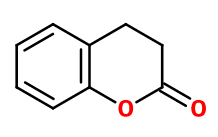
Photo credits: ScenTree SAS
Dihydrocoumarin
Chroman-2-one ; Benzo dihydro pyrone ; Benzo dihydropyrone ; 1,2-benzodihydropyrone ; Dihydrobenzopyranone ; 2-oxo-chroman ; 2-chromanone ; Dihydro coumarin ; 3,4-dihydro-1-benzopyran-2-one ; Dihydrobenzopyrone ; Hydrocoumarin ; Melilotic acid lactone ; Melilotic lactone ; Melilotine ; Melilotol

Photo credits: ScenTree SAS
Do you sell any of the raw materials? Would you like to let our users know?
Send an email to fournisseurs@scentree.coto learn about our advertising opportunities.
Do you sell any of the raw materials? Would you like to let our users know?
Send an email to fournisseurs@scentree.coto learn about our advertising opportunities.
General Presentation
-
CAS N° : 119-84-6
-
EINECS number : 204-354-9
-
FEMA number : 2381
-
Density : 1,169
-
Optical rotation : Donnée indisponible
-
Allergens : This ingredient does not contain any allergen.
-
Refractive Index @20°C : Donnée indisponible
-
Volatility : Base
-
Price Range : €€
-
Appearance : Colorless liquid to solid
-
FLAVIS number : 13.009
-
JECFA number : 1171
Information on synthetic ingredients
-
Acid Value : Donnée indisponible
-
Boiling Point : 272°C
-
Detection Threshold : Donnée indisponible.
-
Molecular formula : C9H8O2
-
Log P : 1
-
Molecular Weight : 148,16 g/mol
-
Fusion Point : 23°C
-
Flash Point : 113°C
-
Vapor pressure : Donnée indisponible
Uses
Other comments :
Dihydrocoumarin does not have a big olfactive difference with Coumarin. This is why it is used as a Coumarin replacer in aromas.
Stability :
Stable in perfumes and diverse functional bases
Uses in perfumery :
Dihydrocoumarin is not so used in perfumery, but widely used in aromas because Coumarin is not edible. Gives a base to fruity notes, gives a dried fruits note. Used in vanilla flavours, alternating with tonka bean and Peru balsam. Used in white chocolate notes to counterbalance acids.
Year of discovery :
Data not available.
Isomerism :
Dihydrocoumarin does not have any isomer used in perfumery.
Synthesis precursor :
Dihydrocoumarin can mediate the synthesis of Hexahydrocoumarin or Octahydrocoumarin. The hydrogenation which allows to obtain these products must be made with the appropriate catalyst and conditions.
Natural availability :
Dihydrocoumarin can be extracted in its natural state from several plants, including medicinal tea and Tarragon EO.
Synthesis route :
Dihydrocoumarin is synthesized from coumarin, by a Raney nickel catalysed hydrogenation reaction. On the other hand, Hexahydrocoumarin can be dehydrogenated during the vapor phase, with a palladium catalysis in order to obtain Dihydrocoumarin.
Regulations & IFRA
-
IFRA 51th : This ingredient is restricted by IFRA
-
Restriction type : RESTRICTION
-
Cause of restriction : DERMAL SENSITIZATION AND SYSTEMIC TOXICITY
-
Amendment : 49
- Quantitative limit on the use :
-
Cat.1 Cat.2 Cat.3 Cat.4 Cat.5A B C DCat.6 0,077 % 0,023 % 0,46 % 0,43 % 0,11 % 0,11 % 0,11 % 0,03 %0,25 % Cat.5A B C DCat.6 0,11 % 0,11 % 0,11 % 0,03 %0,25 % Cat.7A BCat.8 Cat.9 Cat.10A BCat.11A BCat.12 0,88 % 0,88 %0,03 % 0,84 % 0,84 % 3 %0,03 % 0,03 %No Restriction Cat.10A BCat.11A BCat.12 0,84 % 3 %0,03 % 0,03 %No Restriction

